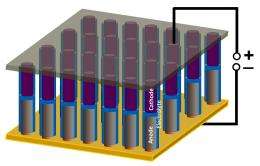August 1, 2011 feature
Energy storage device fabricated on a nanowire array

In a vivid demonstration of the progress being made in miniaturizing energy storage devices, a team of engineers from Rice University in Houston, Texas, has fabricated an energy storage device where all essential components are integrated onto a single nanowire. The nanowire energy storage device could give researchers a better understanding of electrochemistry at the nanoscale, and with optimization could also be used to power nanoelectronic devices.
Rice engineers Sanketh R. Gowda, Arava Leela Mohana Reddy, Xiaobo Zhan, and Pulickel M. Ajayan have published their study on the nanowire energy storage devices in a recent issue of Nano Letters.
“Our work here has for the first time demonstrated the fabrication of all three major components of an energy storage device – anode, electrolyte, and cathode – on a single nanowire,” Ajayan told PhysOrg.com. “This represents the ultimate form of miniaturization promised by nanotechnology and an advance in fabricating more complex and functional nanowire building blocks for future nanotechnology applications.”
The researchers first fabricated a new thin-film hybrid electrochemical system consisting of a nickel-tin (Ni-Sn) anode and polyaniline (PANI) cathode, which showed good electrochemical performance. As a hybrid electrochemical device (HED), the system combines the advantages of batteries (high energy) and supercapacitors (high power) into one design.
To fabricate the same system on a nanowire array, the researchers used nanowire templates with pore diameters of about 200 nm. After coating the pores with a thin copper layer, the researchers filled the pores halfway with Ni-Sn to make the anode. Then the researchers chemically widened the pores in order to coat the Ni-Sn with a thin layer of polyethylene oxide (PEO) electrolyte, which served as the separator. Finally, the PANI cathode was integrated into the structure by an infiltration process. Overall, the entire nanowire was a few micrometers long and had a total area of about 0.5 cm2.
The researchers fabricated several of these devices and then arranged them in a parallel array for testing. By charging and discharging the devices, the researchers demonstrated that the devices have overall good charge/discharge characteristics that could make them attractive for powering nanoelectronic devices.
Another advantage of the nanowire devices is that their electrodes don’t contain any lithium. Although lithium has been used in many batteries and HEDs, it limits the energy density and is expensive to fabricate due to high-temperature synthesis. In contrast, the electrode materials used here (Ni-Sn and PANI) have the advantage of being easily synthesized at room temperature using simple techniques, making them much less expensive.
“With the advancement of nanoelectronic devices, there comes a need for smaller (nano) scale energy sources,” Ajayan said. “With the development of nanoscale power sources, such requirements may be met. In addition, the fabrication of such fully functional devices on individual nanowires could help the scientific community in further probing and better understanding the electrochemistry at nanoscale interfaces. Our device here could serve as a tool to understand important issues such as self-discharge, leakage currents, and the nature of interfacial resistances of nanoscale energy storage devices.”
In the future, the researchers plan to investigate ways to further improve the nanowire device’s performance. For instance, by optimizing the thickness of the separator layer between the two electrodes, they hope to minimize the self-discharge that often plagues batteries with thin separators, as well as improve the low Coulombic efficiency. The researchers also hope to increase the electrode length by using different nanowire templates, which could lead to an increase in the device’s capacity per unit area.
“At this point it is difficult to conjecture the exact devices it could be used to power,” Ajayan said. “We have demonstrated the working of a nanowire array device planted over a geometric area of about 0.5 cm2. Devices at this scale could be used to power several MEMS devices. Ultimately, individual nanowire batteries could each power a few nanowire semiconductor devices, for example.”
More information: Nano Lett., Article ASAP DOI: 10.1021/nl2017042
Provided by Rice University




















